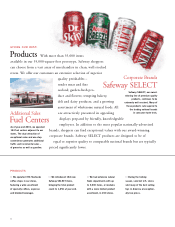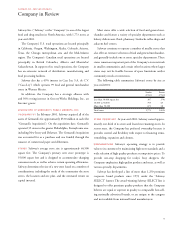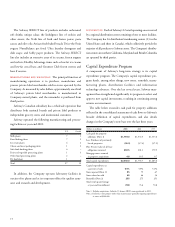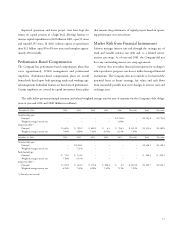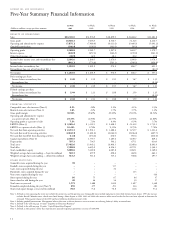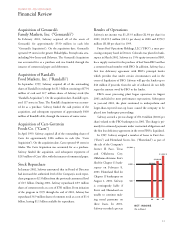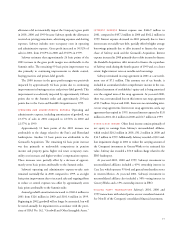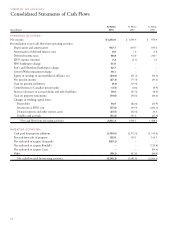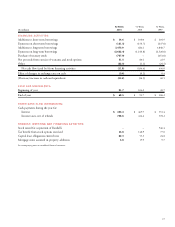Safeway 2001 Annual Report Download - page 18
Download and view the complete annual report
Please find page 18 of the 2001 Safeway annual report below. You can navigate through the pages in the report by either clicking on the pages listed below, or by using the keyword search tool below to find specific information within the annual report.
16
Critical Accounting Policies
Critical accounting policies are those accounting policies that
management believes are important to the portrayal of Safeway’s
financial condition and results and require management’s most
difficult, subjective or complex judgments, often as a result of
the need to make estimates about the effect of matters that are
inherently uncertain.
The Company is primarily self-insured for workers’ compensa-
tion, automobile and general liability costs. It is the Company’s pol-
icy to record its self-insurance liability, as determined actuarially,
based on claims filed and an estimate of claims incurred but not yet
reported. Any actuarial projection of losses concerning workers’
compensation and general liability is subject to a high degree of vari-
ability. Among the causes of this variability are unpredictable exter-
nal factors affecting future inflation rates, litigation trends, legal
interpretations, benefit level changes and claim settlement patterns.
The majority of the Company’s workers’ compensation liabili-
ty is from claims occurring in California. California workers’ com-
pensation has received a tremendous amount of attention from the
state’s politicians, insurers, employers and providers, as well as the
public in general. Recent years have seen an escalation in the num-
ber of legislative reforms, judicial rulings and social phenomena
affecting this business. Some of the many sources of uncertainty in
the Company’s reserve estimates include changes in benefit levels
and medical fee schedules. Other reforms address vocational reha-
bilitation limitations, restrictions on the number of allowed med-
ical-legal evaluations, the treatment of stress and post-termination
claims and the permanent disability rating schedule.
The Company’s workers’ compensation future funding esti-
mates anticipate no change in the benefit structure. Statutory
changes could have a significant impact on future claim costs.
The California Legislature is currently discussing benefit reforms.
At this point it is unknown what, if any, changes will result.
It is the Company’s policy to recognize losses relating to the
impairment of long-lived assets when future cash flows, discounted
using a risk-free rate of interest, are less than the assets’ carrying
value. For stores to be closed that are under long-term leases, the
Company records a liability for the future minimum lease pay-
ments and related ancillary costs from the date of closure to the end
of the remaining lease term, net of estimated cost recoveries. The
Company estimates future cash flows based on its experience and
knowledge of the market in which the store expected to be closed
is located. However, these estimates project cash flow several
years into the future and are affected by variable factors such as
inflation, real estate markets and economic conditions.
Liquidity and Financial Resources
Net cash flow from operating activities was $2,231.3 million in
2001, $1,901.1 million in 2000 and $1,488.4 million in 1999. Net
cash flow from operating activities increased in 2001 and 2000
largely due to increased net income and changes in working capital.
Cash flow used by investing activities was $2,242.3 million in
2001, $1,481.0 million in 2000 and $2,064.3 million in 1999.
Cash flow used by investing activities increased in 2001 primar-
ily because of cash used to acquire Genuardi’s, as well as
increased capital expenditures. Cash flow used by investing activ-
ities declined in 2000, as compared to 1999, primarily due to
cash used to acquire Randall’s and Carrs in 1999, offset, in part,
by increased capital expenditures in 2000 over 1999. Safeway
opened 95 new stores, including 11 former ABCO stores, and
remodeled 255 stores in 2001. In 2000, Safeway opened 75 new
stores and remodeled 275 stores.
Cash flow used by financing activities was $11.8 million in
2001, primarily due to cash flow from operations being used to
pay down debt, almost entirely offset by additional borrowings
related to the Genuardi’s Acquisition. Cash flow used by financ-
ing activities was $434.4 million in 2000 primarily due to cash
flows from operations being used to pay down debt. Cash flow
from financing activities was $636.0 million in 1999 primarily
due to borrowings related to the Randall’s and Carrs acquisitions.
Net cash flow from operating activities as presented in the con-
solidated statements of cash flows is an important measure of cash
generated by the Company’s operating activities. EBITDA, as
defined below, is similar to net cash flow from operations because
it excludes certain noncash items. However, EBITDA also
excludes interest expense and income taxes. EBITDA should not
be considered as an alternative to net income or cash flows from
operating activities (which are determined in accordance with


